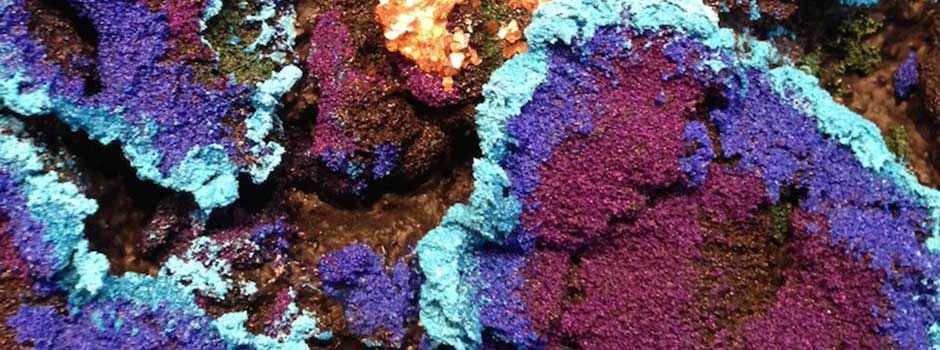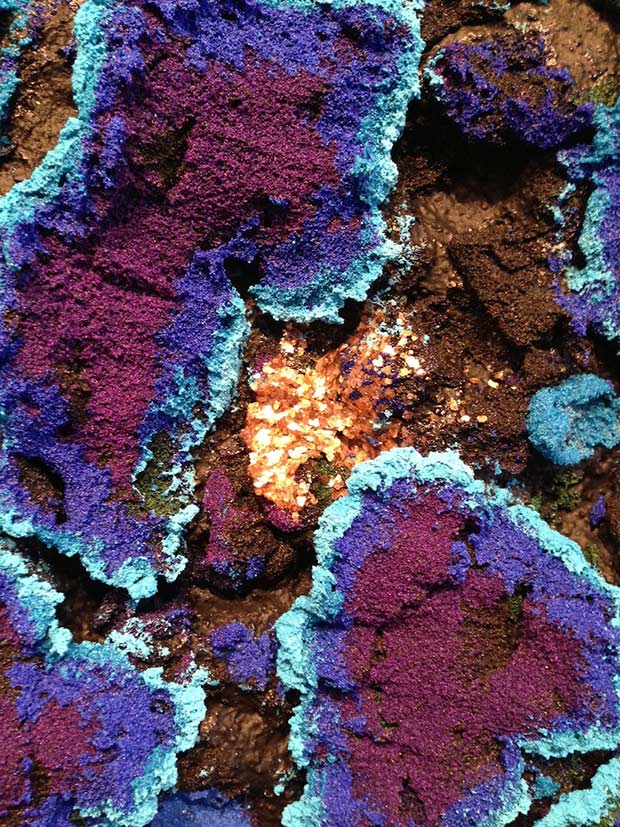
A second solo exhibition at Lawrie Shabibi (17 Nov 2013 – Jan 2014) Nabil Nahas
Oct 11, 2013 Exhibition

 Nabil Nahas, Betty Boop, 2013, Acrylic on canvas,152.4x152.4 cm / Courtesy of Lawrie Shabibi
Nabil Nahas, Betty Boop, 2013, Acrylic on canvas,152.4x152.4 cm / Courtesy of Lawrie Shabibi
Nahas’ heavily encrusted Fractals are built up of ground pumice and acrylic and finished in psychedelic tones. The name Fractals refers to Benoit Mandelbrot ‘s theory of fractal geometry, formulated in the mid-1970s, and describes random events in nature deviating from the ideal Euclidean geometry and rough or fragmented geometric shapes which can be split into parts, each of which is at least approximately a reduced size copy of the whole. Mandelbrot said that things typically considered to be 'rough', a 'mess' or 'chaotic,' like clouds or shorelines, actually had a 'degree of order.' Thus Nahas’ Fractals represent a kind of asymmetrical equilibrium, a relationship between order and disorder that is a recurrent theme in his work.
Ostensibly abstract at first sight, imperceptibly Nabil Nahas’ paintings sidestep the parameters of abstract art. His paintings are literal- his images are always taken from something and often infer movement and refer to a moment in time.
Varying considerably in size and colour, his Fractals evoke a variety of scales and moods. The smallest of them are like windows into an underwater world of coral reefs, whilst the larger works overpower the viewer like the encrusted surface of a leviathan. Subtle variations in tone and colour ripple across their mottled surfaces like the dappled light of tropical waters along the seabed. Their surfaces imitate the encrustations seen in the natural world. The extraordinary Kind of Blue, a large-scale canvas in deep blue is composed of layer upon layer of protruding biomorphic shapes fringed with bright blue edges.
 Nabil Nahas, Mashallah, 2013, Acrylic and Pumice on Canvas, 213x305 cm, 83.78x120.18 in / Courtesy of Lawrie Shabibi
Nabil Nahas, Mashallah, 2013, Acrylic and Pumice on Canvas, 213x305 cm, 83.78x120.18 in / Courtesy of Lawrie Shabibi
Whilst Nahas sees his Fractal paintings as representations of the phenomenal world on a microcosmic scale, his Galactic paintings engage with it on more of a scale that seems more macrocosmic. Rather than the all-over effect of the Fractals, the Galactic paintings are both three-dimensional and graphic, with fluid forms and sinuous lines moving around their surfaces. The lines and shapes on the one hand suggest the interactions and repulsions between heavenly bodies, and on the other they also resemble amoebic life forms. This series incorporates paint chips, a by-product of making Nahas’ larger paintings. The vividly coloured concentric rings are detritus recycled from the studio floor- they are ready-made objects of the artist’s own making, revealing the previously unseen process through which he makes his larger paintings- the built-up under-surfaces of his acrylic-pumice mix. Scale is important in Nahas’ universe, but always ambiguous- what is grandly architectural is also microscopic. This is especially apparent in Inka Dinka Doo, the largest work in the series, which form the centre piece of the exhibition.
This series incorporates paint chips, a by-product of making Nahas’ larger paintings. The vividly coloured concentric rings are detritus recycled from the studio floor- they are ready-made objects of the artist’s own making, revealing the previously unseen process through which he makes his larger paintings- the built-up under-surfaces of his acrylic-pumice mix.
 Nabil Nahas, Mashallah, Detail / Courtesy of Lawrie Shabibi
Nabil Nahas, Mashallah, Detail / Courtesy of Lawrie Shabibi
Nabil Nahas is Lebanon's most renowned artist, having established himself before the current heightened interest in contemporary art of the Middle East, first in New York art circles as a master of colour, texture and atmosphere. Although thoroughly schooled in Western abstract painting, Nahas takes his inspiration from a diverse range of influences, most significantly nature, and occasionally Islamic art, in particular its abstract geometric and chromatic qualities.
His works can be found in the collections of the Metropolitan Museum of Art in New York, the Vorhees Zimmerli Museum, Rutgers University, New Brunswick, New Jersey, and the Colby College Museum of Art, Maine, the Pennsylvania Academy of Fine Arts, Philadelphia, the Flint Institute of Art, Michigan, and the Michigan Museum of Art UMMA. In July 2013 he was awarded the honour of the National Order of the Cedar, for services to Lebanese culture.
Founded in March 2011, Lawrie Shabibi is a contemporary art gallery housed in a 3000 square foot warehouse in Dubai's Al Quoz industrial district. The programme's focus is on supporting established and emerging contemporary artistic talent, primarily from the Middle East, North Africa and South Asia. Lawrie Shabibi regularly publishes catalogues and organizes public programmes such as artist talks and screenings, both at the gallery and non profit spaces in Dubai.
Comments
Add a comment